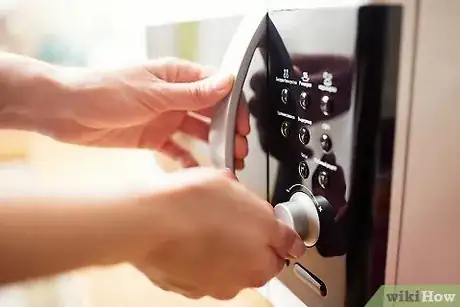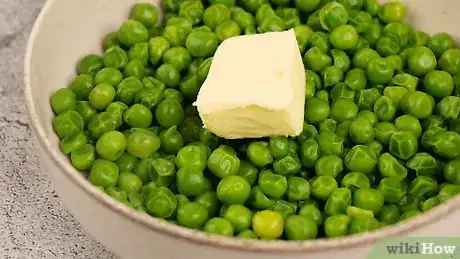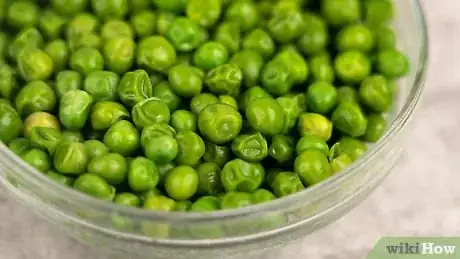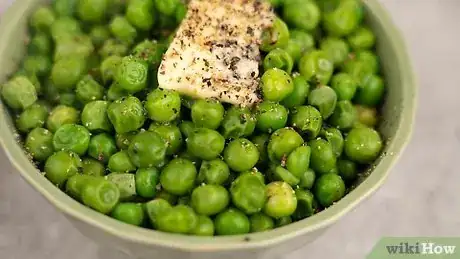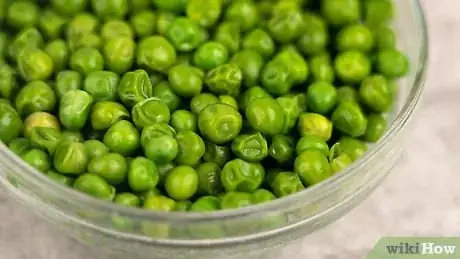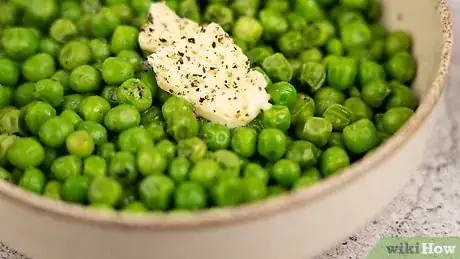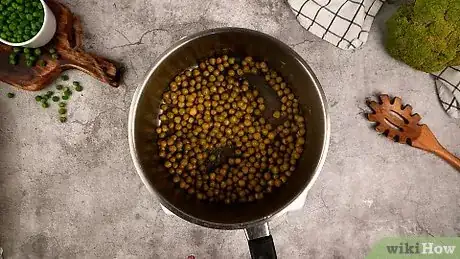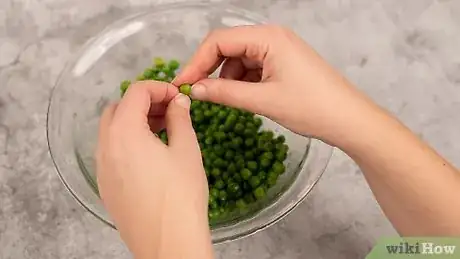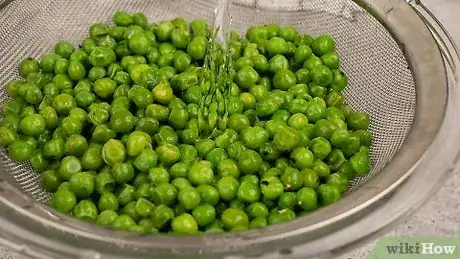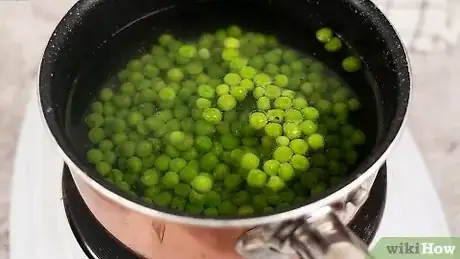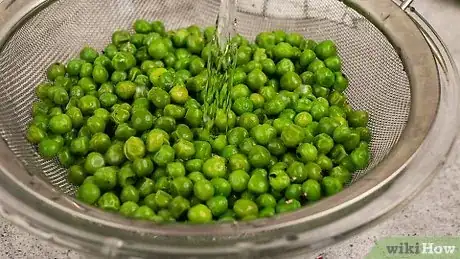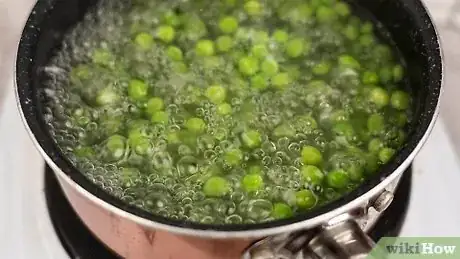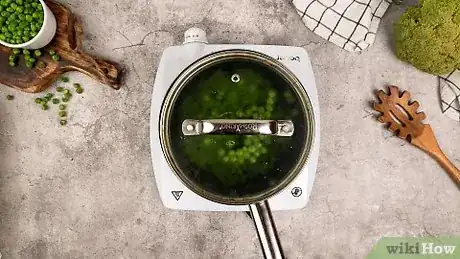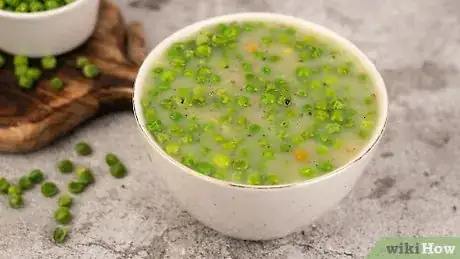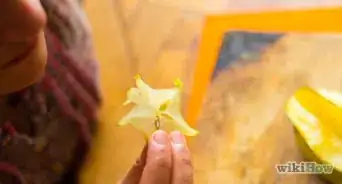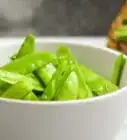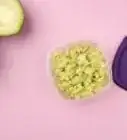This article was co-authored by wikiHow Staff. Our trained team of editors and researchers validate articles for accuracy and comprehensiveness. wikiHow's Content Management Team carefully monitors the work from our editorial staff to ensure that each article is backed by trusted research and meets our high quality standards.
There are 8 references cited in this article, which can be found at the bottom of the page.
The wikiHow Culinary Team also followed the article's instructions and verified that they work.
This article has been viewed 407,369 times.
Learn more...
Peas are sold either fresh, frozen or canned. Fresh peas are in season in the spring while frozen peas are available all year long. Fresh peas come in a pea pod, which needs to be removed prior to cooking the peas. Peas can be cooked in a variety of methods, making a delicious and versatile vegetable for your table.
Steps
Microwaving Fresh or Frozen Peas
-
1Prepare the peas. This method is suitable for frozen peas or fresh peas. It is not suitable for snow peas or sugar snap peas. To prepare the peas, do one of the following:
- Fresh peas: snap the stems off, then tug them downwards to remove the string. Split the pods open, then run your thumb down the center to knock the peas out.
- Frozen peas: simply open the bag and take the peas out. You do not have to do anything else.
-
2Place 1 cup (150 grams) of peas into a microwave-safe dish. You can add more peas, but you will have to adjust the amount of water accordingly. If the frozen peas are clumped together, break them apart with your fingers or a spoon.Advertisement
-
3Cover the peas with 1 to 2 tablespoons of water. You will need 2 tablespoons (30 milliliters) of water for fresh peas, and 1 tablespoon (15 milliliters) of water for frozen peas. Frozen peas require less water than fresh peas because they release extra water while being cooked.[1]
-
4Cover the dish with a sheet of plastic wrap. Be sure to seal the wrap tightly around the rim of the dish so that the steam does not escape.
-
5Cook the peas on HIGH until they are crisp and bright green. This will generally take between 2 and 5 minutes. Keep in mind that each microwave is a little different, and that some microwaves cook much faster than others. It might be a good idea to check your peas after 1 minute of cooking. The general cooking times for fresh and frozen peas are as follows:[2]
- Fresh peas: 5 minutes
- Frozen peas: 2 minutes
-
6Drain the water. Once the peas are cooked, carefully take the dish out of the microwave using a potholder. Peel off the plastic wrap (be mindful of the escaping steam!) and drain the excess water. You can do this by pouring the peas through a strainer.
-
7Serve the peas or use them in your recipe. You can add the peas to your casserole, pasta, or salad. You can also serve them as they are with a dash of salt and a knob of butter.
Steaming Fresh or Frozen Peas
-
1Prepare the peas for steaming, if needed. You can use any type of peas for this method, such as: frozen peas, fresh peas, snow peas, and sugar snap peas. Start out by rinsing the peas, then prepare them as follows:
- Fresh peas: snap the stems off, then pull them down to remove the string. Split the pea pods open, and run your thumb down the center to pop the peas out.
- Frozen peas: open the bag and take the peas out. You do not have to do anything more.
- Snow peas: snap or cut off both ends with your fingers of a knife. You don't have to remove the strings.
- Sugar snap peas: pinch the stems off, then throw out any bruised or damaged peas.
-
2Fill a large pot with water and bring it to a boil over high heat. You will need about 1 to 2 inches (2.54 to 5.08 centimeters) of water.
-
3Insert the steamer basket and add the peas. Make sure that the bottom of the basket is not touching the surface of the water. If the basket is touching the water, pour some water out.
-
4Cover the pot with a lid and let the peas steam for 1 to 3 minutes. The peas are done when they turn crisp and bright green.[3] The cooking times for the various peas are as follows:
- Fresh peas: 1 to 2 minutes
- Frozen peas: 2 to 3 minutes
- Snow peas: 2 to 3 minutes
- Sugar snap peas: 2 to 3 minutes
-
5Remove the peas from the steamer basket and serve them immediately. You can season them with some salt, pepper, and butter. You can also use them in your recipe (ie: casseroles, macaroni and cheese, pasta, etc).
Boiling Fresh or Frozen Peas
-
1Prepare the peas for boiling, if necessary. You can use just about any type of peas for this method, including: frozen peas, fresh peas, snow peas, and sugar snap peas. Start out by rinsing the peas, then prepare them as follows:
- Frozen peas: you do not have to do anything; simply open the bag and take the peas out. Keep in mind that some people find that boiling frozen peas ruins the flavor and texture.[4]
- Fresh peas: snap the stem off and pull it down to remove the string. Split the pea pod open, and run your thumb down the center to pop out the peas.[5]
- Snow peas: snap off both ends with your fingers or cut them off with a knife. You don't have to remove the strings.
- Sugar snap peas: pinch off the stems, then discard any bruised or damaged peas.
-
2Fill a large pot with water and bring it to a boil. You will need 2 quarts (1.9 liters) of water for every 1½ to 2 pounds (715 to 900 grams) of fresh peas or 10 ounces (300 grams) of frozen peas.[6]
- Don't add any salt. This will cause the peas to become tough. You can add a pinch of sugar, however; this will bring out their natural sweetness.[7]
-
3Add the peas and boil them, uncovered, for 1 to 3 minutes. After about 1 minute, test them for doneness and adjust your cooking time accordingly. The peas are done when they are bright green and crisp/tender.[8] The cooking times for the various peas are as follows:
- Fresh peas: 2 to 3 minutes
- Frozen peas: 3 to 4 minutes
- Snow peas: 1 to 2 minutes
- Sugar snap peas: 1 to 2 minutes
-
4Consider draining the peas and tossing them in a large skillet over high heat for 1 minute. This is not completely necessary, but it will dry the peas, and make it easier for butter and other sauces to stick to them.[9] It is not absolutely necessary, but it is highly recommended.
-
5Serve the peas immediately or use them in your recipe. If you have not already done so, drain the peas and shake them in a strainer to get rid of any excess water. An easy way to serve them is to toss them with some salt, pepper, and butter.
Cooking Canned Peas
-
1Open the canned peas and drain the sauce. The peas will still release more liquid as you heat them up. If you leave the sauce in while cooking them, they may get too mushy.
-
2Add the peas into a medium-sized saucepan, and season them if desired. You can add a knob of butter, a dash of salt, and a sprinkle of pepper. You can also add a squeeze of lemon juice as well.[10]
-
3Cook the peas over low to medium-low heat until they are warm to your liking. Canned peas are already cooked, so they just need to be reheated. How warm you want them to be is entirely up to you—just be careful not to overheat them! They should be ready in just 1 or 2 minutes, however.
-
4Serve the peas or use them in your recipe. Canned peas make a great side dish, but they will also taste wonderful in sauces and soups!
Cooking Dried Peas
-
1Go through the dried peas and remove any pebbles or grits of dirt. It would be a good idea to do this, even if you bought the peas packed.
-
2Rinse the peas. Place the peas into a strainer, and place then under cold, running water. Sift them with your hand and keep rinsing them until the water runs clear. Turn off the water and shake the beans to remove any excess water.
-
3Soak the peas in 2 to 3 times the amount of water. The quickest way to soak them is to place them in a pot of water and bring the water to a boil over medium heat. Cook them, uncovered, for 2 minutes, then cover the pot and remove from heat. Let the peas stand for 1½ to 2 hours. Do not add salt.[11]
- Split peas do not need to be soaked.[12]
-
4Drain the water once the peas are done soaking and rinse them with cool water. This will get rid of any indigestible sugars that can cause gas. Do not use this soaking water for cooking.
-
5Fill a large pot with fresh water, then add the peas. Don't add any salt. How much water you use will depend on what type of peas you are cooking. Here are some basic guidelines:[13]
- You will need 3 cups (700 milliliters) of water for each cup (225 grams) of split peas.
- You will need 4 cups (950 milliliters) of water for each cup (225 grams) of whole field peas.
-
6Bring the peas to a rolling boil over high heat. As the beans cook, you may notice some foam on top of the water. Use a slotted spoon to remove the foam off the surface of the water.
-
7Lower the heat to a simmer, cover the pot, and let cook for 1 hour. Once the peas start to boil, reduce the heat to low, and simmer for 1 hour. Stir the peas from time to time so that they don't stick.[14]
-
8Finish the peas according to your recipe once they are done cooking. This may involve adding them to a soup, a dish, or tossing them with a sauce.
Community Q&A
Did you know you can get answers researched by wikiHow Staff?
Unlock staff-researched answers by supporting wikiHow
-
QuestionWhat is a sugar snap pea? Can you eat it whole?
 wikiHow Staff EditorThis answer was written by one of our trained team of researchers who validated it for accuracy and comprehensiveness.
wikiHow Staff EditorThis answer was written by one of our trained team of researchers who validated it for accuracy and comprehensiveness.
Staff Answer wikiHow Staff EditorStaff AnswerA sugar snap pea (also known as the snap pea) was created by crossing the garden pea with the snow pea. Unlike the snow pea, they are rounded. Many of the varieties have a string in them that peels away easily and they have a sweet flavor. And yes, you can eat the pea whole, it is entirely edible although you may wish to peel away the string first and remove any hard stem piece; also, always wash before eating. They can be eaten raw or cooked (steaming is best).
wikiHow Staff EditorStaff AnswerA sugar snap pea (also known as the snap pea) was created by crossing the garden pea with the snow pea. Unlike the snow pea, they are rounded. Many of the varieties have a string in them that peels away easily and they have a sweet flavor. And yes, you can eat the pea whole, it is entirely edible although you may wish to peel away the string first and remove any hard stem piece; also, always wash before eating. They can be eaten raw or cooked (steaming is best). -
QuestionHow do you cook snow peas?
 wikiHow Staff EditorThis answer was written by one of our trained team of researchers who validated it for accuracy and comprehensiveness.
wikiHow Staff EditorThis answer was written by one of our trained team of researchers who validated it for accuracy and comprehensiveness.
Staff Answer wikiHow Staff EditorStaff AnswerSnow peas can be steamed or sauteed, they can also be added to stir-fry dishes. They do not need to be cooked long, as they are tastiest when they still have some snap to them, so aim for around 2 to 5 minutes cooking, and no more. For detailed help with cooking snow peas, check out the wikiHow: How to Cook Snow Peas.
wikiHow Staff EditorStaff AnswerSnow peas can be steamed or sauteed, they can also be added to stir-fry dishes. They do not need to be cooked long, as they are tastiest when they still have some snap to them, so aim for around 2 to 5 minutes cooking, and no more. For detailed help with cooking snow peas, check out the wikiHow: How to Cook Snow Peas. -
QuestionAre peas healthy?
 wikiHow Staff EditorThis answer was written by one of our trained team of researchers who validated it for accuracy and comprehensiveness.
wikiHow Staff EditorThis answer was written by one of our trained team of researchers who validated it for accuracy and comprehensiveness.
Staff Answer wikiHow Staff EditorStaff Answer
wikiHow Staff EditorStaff Answer
Warnings
- Be careful not to overcook peas. Overcooked peas will lose their bright color and flavor.⧼thumbs_response⧽
References
- ↑ http://www.tarladalal.com/How-To-Microwave-Green-Peas-22505r
- ↑ http://www.tarladalal.com/How-To-Microwave-Green-Peas-22505r
- ↑ http://www.recipetips.com/kitchen-tips/t--1141/all-about-peas.asp
- ↑ http://www.thekitchn.com/5-ways-to-make-frozen-vegetables-suck-a-little-less-189312
- ↑ http://www.everydayguide.com/how-to-cook-peas/
- ↑ http://www.recipetips.com/kitchen-tips/t--1141/all-about-peas.asp
- ↑ http://www.bbcgoodfood.com/glossary/peas
- ↑ http://www.recipetips.com/kitchen-tips/t--1141/all-about-peas.asp
- ↑ http://www.recipetips.com/kitchen-tips/t--1141/all-about-peas.asp
- ↑ http://chestofbooks.com/food/recipes/Philadelphia-Cook-Book/How-To-Cook-Peas.html
- ↑ http://www.recipetips.com/kitchen-tips/t--1141/all-about-peas.asp
- ↑ http://startcooking.com/how-to-beans-split-peas-and-lentils
- ↑ http://www.recipetips.com/kitchen-tips/t--1141/all-about-peas.asp
- ↑ http://www.recipetips.com/kitchen-tips/t--1141/all-about-peas.asp
- ↑ http://www.finecooking.com/articles/how-to-buy-store-shell-cook-fresh-peas.aspx?pg=0
- ↑ http://www.finecooking.com/articles/how-to-buy-store-shell-cook-fresh-peas.aspx?pg=0
- ↑ http://www.finecooking.com/articles/how-to-buy-store-shell-cook-fresh-peas.aspx?pg=0
- ↑ http://www.finecooking.com/articles/how-to-buy-store-shell-cook-fresh-peas.aspx?pg=0
- ↑ http://www.everydayguide.com/how-to-cook-peas/
About This Article
To microwave peas, start by putting them in a dish with 1-2 tablespoons of water. Then, cover the dish with plastic wrap, microwave it for 2-5 minutes, and drain any excess water. Alternatively, you can bring a pot of water to a boil, add the peas, and boil them for 1-3 minutes. If you’re cooking fresh peas, snap off the stems, pull them down to remove the strings, and split the shells open to get the peas out before you cook them. Also, adjust your cooking time for fresh peas since they take less time to cook. To learn how to sort, soak, and cook dried peas, keep reading!

